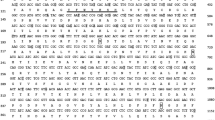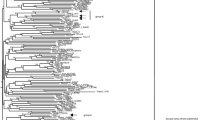Abstract
Laccases are phenol-oxidizing, multicopper enzymes produced by fungi, plants, insects and bacteria. Fungal laccases are involved in ecologically important processes such as decomposition of lignocellulose (wood and plant material). In this work, in order to find out the role of fungal laccases upon wood colonisation and lignin decay, we describe expression of laccase-encoding genes in the white rot basidiomycete Phlebia radiata 79, when the fungus grows on its natural substrates, that is on softwood (Alnus incana) and hardwood (Picea abies). Clones for two laccase-encoding genes, the previously described Pr-lac1 and a new gene Pr-lac2 were characterized. Pr-lac2 coding region is interrupted by 12 introns and the deduced Lac2 protein displays a higher pI value (5.8) than Lac1 (pI 3.2–3.5). Phylogenetic analysis indicates differential evolution for the two laccases, and Lac2 demonstrates the highest sequence identity with Trametes laccases (66%). Transcripts of Pr-lac1 were the most abundant both in solid-state softwood and semi-solid hardwood cultures, as analyzed by competitive RT-PCR and Northern hybridization. On spruce wood chips, Pr-lac1 and Pr-lac2 were expressed within 2–3 weeks of growth together with manganese and lignin peroxidase-encoding genes. Our results indicate wood-promoted but time-dependent regulation of expression for the two, at protein and gene level distinct P. radiata laccases.








Similar content being viewed by others
References
Abbas A, Koc H, Liu F, Tien M (2005) Fungal degradation of wood: initial proteomic analysis of extracellular proteins of Phanerochaete chrysosporium grown on oak substrate. Curr Genet 47:49–56
Alexandre G, Zhulin IB (2000) Laccases are widespread in bacteria. Trends Biotechnol 18:41–42
Baldrian P (2006) Fungal laccases—occurence and properties. FEMS Microbiol Rev 30:215–242
Bourbonnais R, Paice M (1990) Oxidation of non-phenolic substrates. An expanded role for laccase in lignin biodegradation. FEBS Lett 267:99–102
Datta A, Betterman A, Kirk TK (1991) Identification of a specific manganese peroxidase among ligninolytic enzymes secreted by Phanerochaete chrysosporium during wood decay. Appl Environ Microbiol 57:1453–1460
D’Souza TM, Boominathan K, Reddy CA (1996) Isolation of laccase gene-specific sequences from white-rot and brown-rot fungi by PCR. Appl Environ Microbiol 62:3739–3744
Eggert C, Temp U, Dean JF, Eriksson K-E (1996) A fungal metabolite mediates degradation of non-phenolic lignin structures and synthetic lignin by laccase. FEBS Lett 391:144–148
Eriksson K-EL, Blanchette RA, Ander P (1990) Microbial and enzymatic degradation of wood and wood components. Springer, Berlin Heidelberg New York
Giardina P, Cannio R, Martirani L, Marzullo L, Palmieri G, Sannia G (1995) Cloning and sequencing of a laccase gene from the lignin-degrading basidiomycete Pleurotus ostreatus. Appl Environ Microbiol 61:2408–2413
Gilliland G, Perrin S, Bunn HF (1990) Competitive PCR for quantitation of mRNA. In: Innis MA (ed) PCR protocols: a guide to methods and applications. Academic, San Diego, pp 60–69
Hakala TK, Maijala P, Konn J, Hatakka A (2004) Evaluation of novel wood-rotting polypores and corticioid fungi for the decay and biopulping of Norway spruce (Picea abies) wood. Enz Microb Technol 34:255–263
Hakala TK, Lundell T, Galkin S, Maijala P, Kalkkinen N, Hatakka A (2005) Manganese peroxidases, laccases and oxalic acid from the selective white-rot fungus Physisporinus rivulosus grown on spruce wood chips. Enz Microb Technol 36:461–468
Hatakka A (2001) Biodegradation of lignin. In: Hofrichter M, Steinbüchel A (eds) Biopolymers. Wiley-VCH, Weinheim, pp 129–180
Hatakka AI, Uusi-Rauva AK (1983) Degradation of 14C-labelled poplar wood lignin by selected white-rot fungi. Eur J Appl Microbiol Biotechnol 17:235–242
Hildén KS, Martínez AT, Hatakka AI, Lundell TK (2005) The two manganese peroxidases Pr-MnP2 and Pr-MnP3 of Phlebia radiata, a lignin-degrading basidiomycete, are phylogenetically and structurally divergent. Fungal Genet Biol 42:403–419
Hildén KS, Mäkelä MR, Hakala TK, Hatakka A, Lundell T (2006) Expression on wood, molecular cloning and characterization of three lignin peroxidase (LiP) encoding genes of the white rot fungus Phlebia radiata. Curr Genet 49:97–105
Hoegger PJ, Kilaru S, James TY, Thacker JR, Kües U (2006) Phylogenetic comparison and classification of laccase and related multicopper oxidase protein sequences. FEBS J 273:2308–2326
Janse BJH, Gaskell J, Akhtar M, Cullen D (1998) Expression of Phanerochaete chrysosporium genes encoding lignin peroxidases, manganese peroxidases, and glyoxal oxidase in wood. Appl Environ Microbiol 64:3536–3538
Karahanian E, Corsini G, Lobos S, Vicuña R (1998) Structure and expression of a laccase gene from the ligninolytic basidiomycete Ceriporiopsis subvermispora. Biochim Biophys Acta 1443:65–74
Kilaru S, Hoegger PJ, Kües U (2006) The laccase multi-gene family in Coprinopsis cinerea has seventeen different members that divide into two distinct subfamilies. Curr Genet 50:45–60
Kirk TK, Farrell RL (1987) Enzymatic “combustion”: the microbial degradation of lignin. Ann Rev Microbiol 41:465–505
Kumar S, Tamura K, Jakobsen IB, Nei M (2001) MEGA: molecular evolutionary genetics analysis software. Bioinformatics 17:1244–1245
Kumar SVS, Prashant SP, Durani S, Wangikar PP (2003) Combined sequence and structure analysis of the fungal laccase family. Biotechnol Bioeng 83:386–394
Kües U, Liu Y (2000) Fruiting body production in Basidiomycetes. Appl Microbiol Biotechnol 54:141–152
Larrondo LF, Salas L, Melo F, Vicuña R, Cullen D (2003) A novel extracellular multicopper oxidase from Phanerochaete chrysosporium with ferroxidase activity. Appl Environ Microbiol 69:6257–6263
Langfelder K, Streibel M, Bernhard J, Haase G, Brakhage AA (2003) Biosynthesis of fungal melanins and their importance for human pathogenic fungi. Fungal Genet Biol 38:143–158
Lundell T, Leonowicz A, Rogalski J, Hatakka A (1990) Formation and action of lignin-modifying enzymes in cultures of Phlebia radiata supplemented with veratric acid. Appl Environ Microbiol 56:2623–2629
Mäkelä M, Galkin S, Hatakka A, Lundell T (2002) Production of organic acids and oxalate decarboxylase in lignin-degrading white rot fungi. Enz Microb Technol 30:542–549
Mansur M, Suárez T, Fernández-Larrea JB, Brizuela MA, González AE (1997) Identification of a laccase gene family in the new lignin-degrading basidiomycete CECT 20197. Appl Environ Microbiol 63:2637–2646
Mansur M, Suárez T, González AE (1998) Differential gene expression in the laccase gene family from basidiomycete I-62 (CECT 20197). Appl Environ Microbiol 64:771–774
Martínez AT (2002) Molecular biology and structure function of lignin-degrading heme peroxidases. Enz Microb Technol 30:425–444
Martinez D, Larrondo LF, Putnam N, Gelpke MD, Huang K, Chapman J, Helfenbein KG, Ramaiya P, Detter JC, Larimer F, Coutinho PM, Henrissat B, Berka R, Cullen D, Rokhsar D (2004) Genome sequence of the lignocellulose degrading fungus Phanerochaete chrysosporium strain RP78. Nat Biotechnol 22:695–700
Mayer AM, Staples RC (2002) Laccase: new functions for an old enzyme. Phytochemistry 60:551–565
Moilanen A-M, Lundell T, Vares T, Hatakka A (1996) Manganese and malonate are individual regulators for the production of lignin and manganese peroxidase isozymes and in the degradation of lignin by Phlebia radiata. Appl Microbiol Biotechnol 45:792–799
Ohga S, Royse DJ (2001) Transcriptional regulation of laccase and cellulase genes during growth and fruiting of Lentinula edodes on supplemented sawdust. FEMS Microbiol Lett 201:111–115
Palmieri G, Giardina P, Bianco C, Fontanella B, Sannia G (2000) Copper induction of laccase isoenzymes in the ligninolytic fungus Pleurotus ostreatus. Appl Environ Microbiol 66:920–924
Palmieri G, Bianco C, Cennamo G, Giardina P, Marino G, Monti M, Sannia G (2001) Purification, characterization, and functional role of a novel extracellular protease from Pleurotus ostreatus. Appl Environ Microbiol 67:2754–2759
Piontek K, Antorini M, Choinowski T (2002) Crystal structure of a laccase from the fungus Trametes versicolor at 1.90-Å resolution containing a full complement of coppers. J Biol Chem 277:37663–37669
Saloheimo M, Niku-Paavola M-L, Knowles JKC (1991) Isolation and structural analysis of the laccase gene from the lignin-degrading fungus Phlebia radiata. J Gen Microbiol 137:1537–1544
Sato Y, Wuli B, Sederoff R, Whetten R (2001) Molecular cloning and expression of eight laccase cDNAs in loblolly pine (Pinus taeda). J Plant Res 114:147–155
Schneider P, Caspersen MB, Mondorf K, Halkier T, Skov LK, Østergaard PR, Brown KM, Brown SH, Xu F (1999) Characterization of a Coprinus cinereus laccase. Enz Microb Technol 25:502–508
Smith M, Shnyreva A, Wood DA, Thurston CF (1998) Tandem organization and highly disparate expression of the two laccase genes lcc1 and lcc2 in the cultivated mushroom Agaricus bisporus. Microbiology 144:1063–1069
Soden DM, Dobson ADW (2001) Differential regulation of laccase gene expression in Pleurotus sajor-caju. Microbiology 147:1755–1763
Thurston CF (1994) The structure and function of fungal laccases. Microbiology 140:19–26
Tien M, Kirk TK (1988) Lignin peroxidase of Phanerochaete chrysosporium. In: Wood WA, Kellogg ST (eds) Methods in Enzymology. Academic, San Diego, pp 238–349
Valderrama B, Oliver P, Medrano-Soto A, Vazquez-Duhalt R (2003) Evolutionary and structural diversity of fungal laccases. Antonie Van Leeuwenhoek 84:289–299
Vares T, Kalsi M, Hatakka A (1995) Lignin peroxidases, manganese peroxidases, and other ligninolytic enzymes produced by Phlebia radiata during solid-state fermentation of wheat straw. Appl Environ Microbiol 61:3515–3520
Wariishi H, Valli K, Gold MH (1992) Manganese(II) oxidation by manganese peroxidase from the basidiomycete Phanerochaete chrysosporium. Kinetic mechanism and role of chelators. J Biol Chem 267:23688–23695
Yaver DS, Golightly EJ (1996) Cloning and characterization of three laccase genes from the white-rot basidiomycete Trametes villosa: genomic organization of the laccase gene family. Gene 181:95–102
Yaver DS, Xu F, Golightly EJ, Brown KM, Brown SH, Rey MW, Schneider P, Halkier T, Mondorf K, Dalbøge H (1996) Purification, characterization, molecular cloning, and expression of two laccase genes from the white rot basidiomycete Trametes villosa. Appl Environ Microbiol 62:834–841
Yaver DS, Overjero MDC, Xu F, Nelson BA, Brown KB, Halkier T, Bernauer S, Brown SH, Kauppinen S (1999) Molecular characterization of laccase genes from the basidiomycete Coprinus cinereus and heterologous expression of the laccase Lcc1. Appl Environ Microbiol 65:4943–4948
Acknowledgments
The Viikki Graduate School of Biosciences doctoral study positions for M. Mäkelä and T. Hakala, and financial support from the Academy of Finland (grants no. 53305 and 205027) to the Center of Excellence on Microbial Resources, and University of Helsinki (project no. 2108015) is gratefully acknowledged.
Author information
Authors and Affiliations
Corresponding author
Additional information
Communicated by U. Kück
Rights and permissions
About this article
Cite this article
Mäkelä, M.R., Hildén, K.S., Hakala, T.K. et al. Expression and molecular properties of a new laccase of the white rot fungus Phlebia radiata grown on wood. Curr Genet 50, 323–333 (2006). https://doi.org/10.1007/s00294-006-0090-1
Received:
Revised:
Accepted:
Published:
Issue Date:
DOI: https://doi.org/10.1007/s00294-006-0090-1




